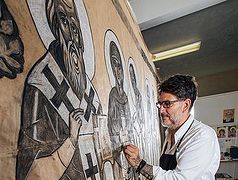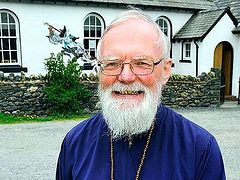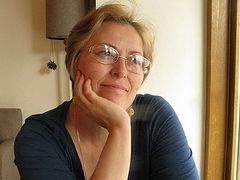Source: Richmond Magazine
December 22, 2015
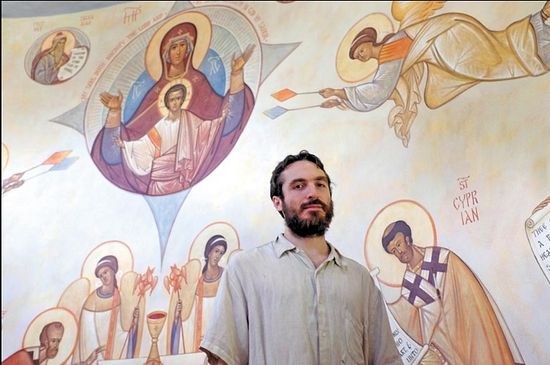 Seraphim is an iconographer, and the icons he is painting aren’t supposed to express a private vision or even offer realistic likenesses of the individual saints he depicts. “Icons are images that help us in worship,” he says. “They are to glorify God. We are to look through them to glimpse God in his glory.” (Photo by Jay Paul)
Seraphim is an iconographer, and the icons he is painting aren’t supposed to express a private vision or even offer realistic likenesses of the individual saints he depicts. “Icons are images that help us in worship,” he says. “They are to glorify God. We are to look through them to glimpse God in his glory.” (Photo by Jay Paul) It’s a quiet summer morning at St. Cyprian of Carthage Orthodox Church on a country road in Midlothian. Seraphim O’Keefe, born Conor O’Keefe on Christmas Day in 1982, has been painting images on the church walls since 6 a.m. Because it is hot in the church, he is barefoot, which seems fitting. There is something saintly about this Richmond native, whose story is in some ways as dramatic as that of St. Jacob, the monk whose robe he is now painting.
Seraphim, who turns 33 this month, brushes a stroke of pigment onto the wall and winces as if dissatisfied with his efforts. “St. Jacob,” he says in a halting voice that is almost childlike, “was one of the first American-born priests of the Eastern Orthodox Church. When Alaska was under Russian control, Jacob sided with the native Aleuts who were being forced into slavery by the fur trappers, who murdered him.”
Seraphim has himself suffered for his faith — and for his art. In January 2004, he was living 6,000 miles from home in the independent country of Georgia, where he could study the iconography he now does full time. He was helping build the Alaverdi Monastery on a steep mountainside, and what happened there one day is something his mother, Cristy O’Keefe, still has trouble discussing. That her son did not die on the mountain sparked rumors that a miracle had saved him — rumors church leaders were quick to discourage.
“They didn’t want anybody talking about what happened to him that day,” says John Wurdeman, the founder of Lazare Gallery in Charles City County, an O’Keefe family friend, and one of the few people who know the story. “They said it was because they didn’t want pilgrims coming from all over to see where this ‘miracle’ occurred. Seraphim himself was even instructed not to tell his parents about it. Of course, he probably wouldn’t have talked about it, anyway. He might think it was bragging.”
What Seraphim will talk about, and with enthusiasm, is his work. “What I’m doing looks like frescoes,” he says of the images of saints he is painting at St. Cyprian’s. “But this is dry plaster. Compared to frescoes, it’s permanent.”
Permanence is important to Seraphim, who thinks in terms of centuries when the culture around him reveals itself through Instagram. When he completes his images of Jacob and the other saints arrayed alongside him, Seraphim will paint lettering on the scrolls they carry. “The words will be from the anaphora —the high point of our worship — of St. John Chrysostom. The words go back 1600 years.”
Seraphim is an iconographer, and the icons he is painting aren’t supposed to express a private vision or even offer realistic likenesses of the individual saints he depicts. “Icons are images that help us in worship,” he says. “They are to glorify God. We are to look through them to glimpse God in his glory.”
Americans have a tough time understanding iconography, which runs counter to our notions of art and our deeply ingrained individualism. “For most of us, steeped in modern and contemporary art, originality is seen as the highest value,” says Seth Feman of Norfolk’s Chrysler Museum, which, through Jan. 10, is hosting the exhibition “Saints and Dragons: Icons from Byzantium to Russia.”
With iconography, “what is valued is the ability to replicate prototypes, which is the source of power of these objects,” Feman says. “The differences in icons can be so subtle as to be imperceptible to the casual viewer. The forms, the quality of line — all of that is to be preserved. Sometimes the only perceptible differences are in the adornment — the pearls, semiprecious stones, gilding and maybe worked metal.”
Learning to paint icons takes years of serious study, says Albert Epshteyn, a Russian immigrant who teaches painting at Virginia Commonwealth University. “Icons are products of the great tradition of Russian art pedagogy, where the student undergoes meticulous instruction over decades. In this tradition, craftsmanship and preparation take precedence over almost every other consideration.”
There are, at present, “maybe a dozen” elite iconographers in the world, Seraphim says. “These are the ones who know each others’ names and their work — one in England, a couple in Greece, one in Romania, some in Russia. At this point, I’d probably be considered ‘an interesting beginner.’”
Becoming a competent iconographer doesn’t happen overnight, but Seraphim’s reputation is growing, and commissions are coming in, almost always by word of mouth. “Seraphim is not in any hurry,” Wurdeman says. “He appreciates the slow path.”
So far, Seraphim’s path has been slow — and slippery. Cristy O’Keefe and his father, Kelly O’Keefe, a professor at the VCU Brandcenter, have been to the very spot where the Jan. 1, 2014, miracle did or did not take place, but Cristy couldn’t bring herself to look. “As soon as we found out what had happened, which was eight months afterward, we flew to Georgia to see for ourselves that our son was OK,” Cristy says. “But he wasn’t.”
Some months earlier, in mid-2003, Seraphim, eager to improve his skills as an iconographer by deepening his commitment to the church, had decided to become a monk-in-training. “So he was living at this monastery, doing whatever the church leader, this famous mystic, told him to do,” Cristy says. “He was living in this cell, and he wasn’t eating properly ... Part of his work was helping build the monastery, a very primitive structure on a cliff on this mountainside, where the most ‘modern’ tool they could use to move the boulders to the job site was an old-fashioned pulley. They had him on this icy roof, wearing a cassock.”
It was a snowy morning. “They had a zero-waste policy at the monastery, so they had me on the roof, straightening used nails,” Seraphim recalls. “The way we kept warm was to do bursts of hard labor, so I decided to carry some stones up to the next level of the roof, to get my blood circulating. I stepped onto a stool to get up to the next level.”
His foot, or the stool, slipped. The next thing he remembers was tumbling down the cliff. When he regained consciousness, he was hanging upside down from the top of a tree. The branches holding him then broke, and he crashed to the ground. “I guess I felt kind of goofy for a while, because I tried to stand up and thought I could just climb back up that vertical cliff,” he says. “But I couldn’t even climb 2 feet up it, so I had to bushwhack my way back up the side of the mountain. When I got there about three hours later, the other workers asked me where I’d been and why I was late. They thought I had just been slacking off, and that’s a big deal at the monastery. So I took them to the edge of the cliff to point out the top of the tree where the branches broke off.”
Estimates vary, but he seems to have fallen between 70 and 150 feet. That he hadn’t died, people said, was a miracle. Word spread. Church officials said they were afraid pilgrims would start showing up to visit the spot. “But I think they were just afraid of bad publicity for the monastery project, that this American almost died there,” Seraphim says.
“What he told me,” Cristy says, “is that they just looked him over and put him back to work. They didn’t have him X-rayed for internal injuries or anything. He has always been an extremely conscientious kid, and he was very serious about his commitment to the church, so he did what they told him to do. He just went back to work.”
But he wasn’t nearly ready. He was sick already, from poor diet and little sleep. His psychological state was also precarious. He had battled depression since his days at Trinity High School and, although he had converted to Christianity — unsettling to his parents, who are forthright atheists — he was still, in his own words, “in a very dark place. I would scream and pound on the wall of my cell,” he says. “I wasn’t getting to do any art at the monastery, and I was really going nuts. I couldn’t keep anything down. I turned green. Eventually, I guess they realized something really was wrong with me. I kind of washed out as a monk, so, after little more than a year, in October 2004, they sent me back to Sighnaghi.”
Sighnaghi is in Georgia’s easternmost region of Kakheti, one of the country’s smallest towns, with a population of about 2,000. Sighnaghi has been Seraphim’s home, on and off, ever since he left Richmond. It was to Sighnaghi that Seraphim — then Conor — wanted to move after graduating from Trinity in 2001.
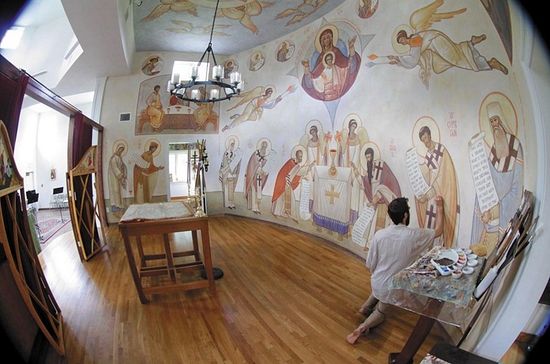 “I’d like to paint one of the murals that are appearing around town,” Seraphim says. “I’d like to bring more of a spiritual sensibility to them. That would be great.” (Photo by Jay Paul)
“I’d like to paint one of the murals that are appearing around town,” Seraphim says. “I’d like to bring more of a spiritual sensibility to them. That would be great.” (Photo by Jay Paul) As part of a summer arts program, he had visited Sighnaghi between his junior and senior years and admired the realist landscapes produced in Russia. Although he had been accepted at the Rhode Island School of Design, Conor wanted the intensive academic training that you can get only in the former Soviet Union. The O’Keefes also knew their eldest of four sons had been serious about art from an early age. “One winter, he and his brothers built a treehouse in the woods behind our home,” Kelly says. “When the other boys were back inside and there was snow on the ground, Conor would be out there in that treehouse for hours, painting winter landscapes.”
So, after graduation, over his parents’ strong objections, Conor moved to Sighnaghi. “Almost overnight I went from being this kid from the American suburbs who liked the Grateful Dead to loving Georgian folk music — and Georgian church music,” he says.
The people of Sighnaghi are not only hospitable but also deeply religious. “They are very poor,” Seraphim says, “but food is cheap and abundant, and they have a great tradition of feasting. Food is piled high on the tables, and the ritual of toasting encourages you to talk about the deepest questions of life and faith with the person seated next to you. The church choir prepares the food, and these feasts last for hours, and with all the wine, by the end of the feast, you know the person you are sitting with better than you know the person you think of as your best friend.”
Before long, Conor was attending worship services and immediately felt “a deep connection” to the Orthodox faith, to its music, its monasteries and its monks. When this child of untroubled nonbelievers decided not only to join the church but also to become a monk, “it was a difficult to accept, though it has become easier over time,” Cristy says. “There is no question that he has undergone a deep spiritual experience and is a fervent convert. And Conor knows what he is about, and it seems to be working out for him.”
“Would I like my parents to be Christians? Sure,” Seraphim says. “But my understanding of Christianity is it doesn’t give you more of a shot at salvation; it just gives you more responsibility. The more you follow the disciplines of the church, the more you can see yourself for what you are, and when I go home, it is easy for me to see the ways in which my parents and brothers and friends do a better job than I do at being a Christian, whatever they happen to believe — seeking truth, for example, or showing love to their neighbor.
“And it isn’t like I had some sudden moment of spiritual ‘enlightenment,’ and that those ‘dark periods’ I experienced suddenly went away,” he says. “But I knew something significant was going on, and I felt a pull to be part of it.”
He remembers coming back to Richmond around Christmas of 2001, several months after he had first moved to Sighnaghi. “I put two paper icons on my bedroom wall, and with no background at all, I started to read the Bible. But I was also reading The Tao of Pooh at the time, which gives you some idea of how unfocused I was.”
It was in early 2002, before returning to Sighnaghi, that he decided to be baptized. The sacrament was performed at the Monastery of St. Herman of Alaska, in Platina, California. He didn’t know that he was supposed to have picked out a new name for himself, so the priest who baptized him chose one, naming him for Seraphim, a Russian saint. “I was eager to get back to Georgia and pursue my art and my faith more seriously. I wanted to go back, which I did, shortly after my baptism. I wanted ‘to find the meaning of life.’ ”
In 2003, after several months painting in Sighnaghi, he decided to become a monk, which led him to the monastery. “I stayed at the monastery from the middle of 2003 until the fall of 2004, when they sent me back to Sighnaghi for a few weeks to recover from that dark state of mind I experienced there.” He then came back to Richmond, where he spent Christmas of 2004, “feeling like a complete failure.” He was in and out of hospitals for about five months. As soon as he was feeling well enough to travel, he went straight to Moscow. There, for about a year, he studied art under Nikolai Kozlov, who teaches at the preparatory school for the prestigious Surikov Institute. Seraphim lived in a room above a restaurant in a run-down, high-crime suburb of the city. He had almost no money.
Seraphim was supposed to be in Moscow for two years. “But I could only make it for a year and, in the summer of 2006, I came back to Richmond,” he says. “I felt like I’d failed at art just like I’d failed at the monastery — like a complete failure at everything.”
Back home, he rested and painted and, starting in the spring of 2007, for about four months, he lived and worked on a farm in Floyd County. “That was therapeutic,” he says. “There was fresh air, outdoor activity, a church and a priest nearby that I liked — St. Innocent of Alaska [Eastern Orthodox] Mission and Father Michael Furry. That allowed me to get back on my feet to the point I could get on with my life.”
“[On the farm], my body and my mind had time to allow the ‘cure’ for what most people know as depression really began to take hold,” he says. “While I think there probably is a biochemical and even genetic reality to what I was experiencing, I also believe that the cure actually began at the monastery back in Georgia. Things got to their deepest and darkest level there, but I can still feel in my body the cure beginning to work itself out, even in that fall down the mountain, maybe. I can still feel that taking hold. Maybe something biochemically reversed itself. I don’t know, but I do know that I no longer feel like I am ever again going to go over the edge, mentally, the way I once feared.”
Gradually, things did begin to improve. In the fall of 2007, when Seraphim learned that Zedashe Ensemble, a Georgian choir, was making an American tour, he signed on to drive the group’s bus. At the group’s stop in Chicago, he met a young woman, born Jessica Wolfe. Another American smitten with the way of life that endures, century upon century, on the Black Sea, Jessica, who performs and teaches Georgian music, had also converted to the Eastern Orthodox faith and is now known as Ilaria. The two became friends and, on August 29, 2010, the pair wed.
After Seraphim and Ilaria were married, they moved to Georgia, then to an Orthodox community in Kodiak, Alaska, where he painted and she taught music. They returned to the United States for the birth of their first child, Herman. While Seraphim was completing a two-year painting assignment at Holy Cross Orthodox Church in Linthicum Heights, Maryland, their daughter, Ida, was born.
“It is really something to see this sometimes painfully diffident young man, who always seemed to have not quite connected to the culture in which he was raised, turn out to be a very natural husband and father, with this beautiful, talented wife and children,” Wurdeman says. “The church provides them with housing, and I don’t know what kind of retirement plan they have, but it is a wonderful thing to witness, this happy family life he has.”
In the fall, Seraphim, Ilaria, Herman and Ida were off to Saint Vladimir’s Orthodox Theological Seminary in Yonkers, New York, where Seraphim continues his studies, and Ilaria furthers her musical education. In 2018, after three years of academic work, he will receive his master’s in divinity. There is talk of a summer 2017 painting project at a church in Warrenton, and work at St. Cyprian’s might continue, as a building expansion goes forth.
Seraphim hopes to find time, too, for some amusement. “I’ve drawn comics for years, and when some of my work was published in a comics quarterly, reviewers compared it to Winsor McCay, which was a real compliment,” he says. “But my heroes were always George Herriman, who drew ‘Krazy Kat,’ and E.C. Segar, who drew the early ‘Popeye.’ That stuff never gets old.”
He still enjoys Richmond, and there is one project he would like to tackle close to home. “I’d like to paint one of the murals that are appearing around town,” Seraphim says. “I’d like to bring more of a spiritual sensibility to them. That would be great.”

